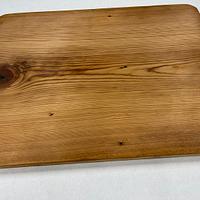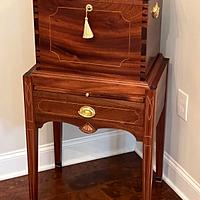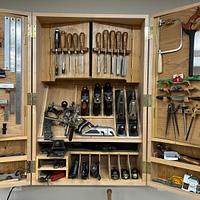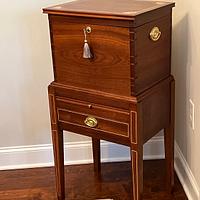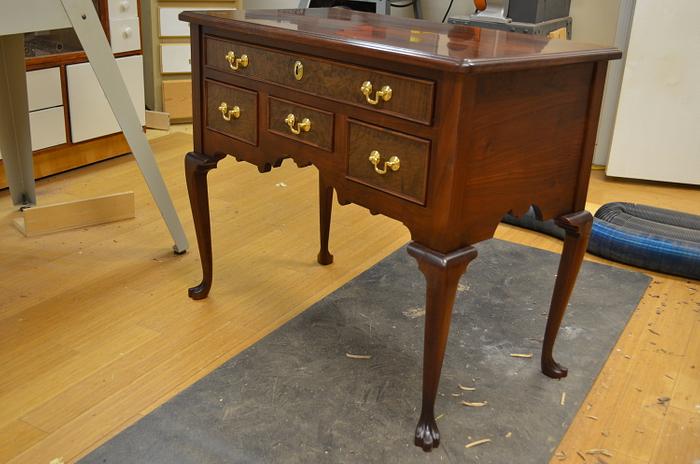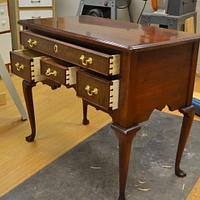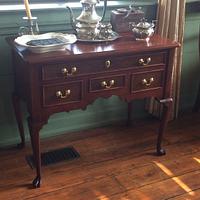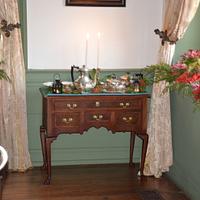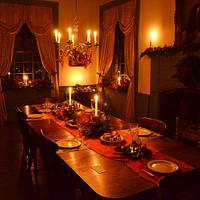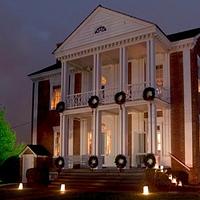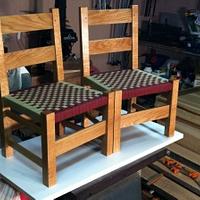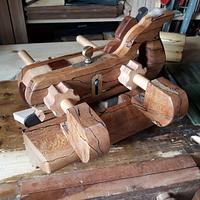Share your craft projects
Make new craft buddies
Ask craft questions
Blog your craft journey
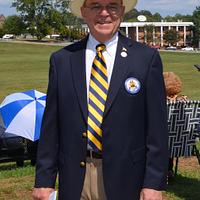
Carey Mitchell
169 posts
and
11 followers
in almost 3 years
in almost 3 years
More from Carey Mitchell
Queen Anne lowboy
This piece was constructed to go in a local historic site in northwest Georgia, a mansion built by a Cherokee chief in 1804, so the period had to be correct. The original of this piece was made around 1790. The last 2 photos show it in its home in the historic house, the latter while the house was decorated for Christmas candlelight tours.
The house was part of a plantation that was owned by James Vann and later his son , Joseph. James Vann's father was a Scottish trader and his mother was a Cherokee. The elder Vann, James, was the first to bring Moravian missionaries, who arrived in Georgia in 1735, into Cherokee country to educate the children in the late 1700s. We have a very good history of the times from the extensive Moravian diaries, some of which are only today being translated from the old high German (alte hoch Deutsch); many thousands of pages. James was murdered when his son, Joseph, was 14. "Rich Joe" Vann apparently inherited his father's business acumen and eventually owned 3 plantations in Ga and TN, numerous mills, ferries, toll roads, taverns, etc., and was considered one of the richest men in the south. President Monroe visited in 1819 to meet this fabulously wealthy Native American.
A few years back, I learned that one of my great, great grandfathers had owned the house and surrounding acres 1875-1879. Then I found an old deed where a different great, great grandfather bought 160 acres of the former plantation in 1841, not long after the Cherokees were removed in 1838 (Vann saw it all coming and left for Oklahoma in 1832. He was to be prosecuted and his lands confiscated by the state of GA because he had hired a white man as overseer of his slaves - state law at the time prohibited Indians from employing whites! They had waited for years to confiscate his property and finally got him with this infraction).
So, a family connection that I never knew about. I got interested, became a docent, became more involved and was elected to the Board of Trustees. I also learned that that same great, great grandfahter had also owned property where one of the forts used to assemble the Cherokees for the Trail of Tears was previously located.
During the Candlelight Tours in 2024, I was hosting in the dining room. A lady introduced herself and related that her great-great grandfather had owned the place from 1871-1875. We immediately went to the museum and verified from records that my great, great grandfather had purchased it form hers. Amazing coincidence !
I do some repair work on some of the antiques in the house. They want me to fix a cracked leg on a Queen Anne highboy that was appraised at near $80K - no way ! I have made a couple of other small pieces for the house.
I did this in walnut, although the original from the 1790's was mahogany. This was my first try at the trifid form of Queen Anne feet, and they turned out to be easier than I expected. The legs are considerably slimmer and the knee more angular than other QA legs I have done. I recessed the aprons 3/16" from the legs simply because I like the depth it gives. In order to use veneer on the drawer fronts I used flush fitting drawers rather than overlay as in the original and added a cockbead molding to protect the edges of hte veneer. The half blind dovetails were hand cut, of course.
In the interest of tradition, I used a number of antique tools; one of the spokeshaves used on the legs was my great-grandfather's (1859-1950), as was the Stanley #6 plane and the dividers (seen in the hanging tool cabinet), all 100+ years old - he lived on a hill 1/4 mile from the historic site, on the 160 acres purchased by his father in 1841. Hide glue, naturally.
I used drawer slips and beveled bottoms, as in the original. The finish is Transtint brown mahogany dye at 1/4 strength, followed by tung oil, then 3 coats of 50/50 satin/semigloss varnish. I would love to do another of these in mahogany; I would do a lot of things differently - I suppose that happens to us all; maybe someone will want to pay me to build another! A second go at it would take about 1/2 the time.
The last photos show it in place in the historic site. Dining room by candlelight, with lowboy in background.
Interesting to note that the exterior walls are 24" thick - solid brick, made on the property. The interior walls are 12" thick, also solid brick. The massive earthquakes in TN at New Madrid in 1811-1812 destroyed most buildings even here; this house had not a single crack. The quakes were felt as far as Charleston, SC.
If history had been taught like this, I would have loved it; but the way it was taught, i.e., memorize hundreds of dates and people, etc., left me cold and I hated history. This, I love.
The house was part of a plantation that was owned by James Vann and later his son , Joseph. James Vann's father was a Scottish trader and his mother was a Cherokee. The elder Vann, James, was the first to bring Moravian missionaries, who arrived in Georgia in 1735, into Cherokee country to educate the children in the late 1700s. We have a very good history of the times from the extensive Moravian diaries, some of which are only today being translated from the old high German (alte hoch Deutsch); many thousands of pages. James was murdered when his son, Joseph, was 14. "Rich Joe" Vann apparently inherited his father's business acumen and eventually owned 3 plantations in Ga and TN, numerous mills, ferries, toll roads, taverns, etc., and was considered one of the richest men in the south. President Monroe visited in 1819 to meet this fabulously wealthy Native American.
A few years back, I learned that one of my great, great grandfathers had owned the house and surrounding acres 1875-1879. Then I found an old deed where a different great, great grandfather bought 160 acres of the former plantation in 1841, not long after the Cherokees were removed in 1838 (Vann saw it all coming and left for Oklahoma in 1832. He was to be prosecuted and his lands confiscated by the state of GA because he had hired a white man as overseer of his slaves - state law at the time prohibited Indians from employing whites! They had waited for years to confiscate his property and finally got him with this infraction).
So, a family connection that I never knew about. I got interested, became a docent, became more involved and was elected to the Board of Trustees. I also learned that that same great, great grandfahter had also owned property where one of the forts used to assemble the Cherokees for the Trail of Tears was previously located.
During the Candlelight Tours in 2024, I was hosting in the dining room. A lady introduced herself and related that her great-great grandfather had owned the place from 1871-1875. We immediately went to the museum and verified from records that my great, great grandfather had purchased it form hers. Amazing coincidence !
I do some repair work on some of the antiques in the house. They want me to fix a cracked leg on a Queen Anne highboy that was appraised at near $80K - no way ! I have made a couple of other small pieces for the house.
I did this in walnut, although the original from the 1790's was mahogany. This was my first try at the trifid form of Queen Anne feet, and they turned out to be easier than I expected. The legs are considerably slimmer and the knee more angular than other QA legs I have done. I recessed the aprons 3/16" from the legs simply because I like the depth it gives. In order to use veneer on the drawer fronts I used flush fitting drawers rather than overlay as in the original and added a cockbead molding to protect the edges of hte veneer. The half blind dovetails were hand cut, of course.
In the interest of tradition, I used a number of antique tools; one of the spokeshaves used on the legs was my great-grandfather's (1859-1950), as was the Stanley #6 plane and the dividers (seen in the hanging tool cabinet), all 100+ years old - he lived on a hill 1/4 mile from the historic site, on the 160 acres purchased by his father in 1841. Hide glue, naturally.
I used drawer slips and beveled bottoms, as in the original. The finish is Transtint brown mahogany dye at 1/4 strength, followed by tung oil, then 3 coats of 50/50 satin/semigloss varnish. I would love to do another of these in mahogany; I would do a lot of things differently - I suppose that happens to us all; maybe someone will want to pay me to build another! A second go at it would take about 1/2 the time.
The last photos show it in place in the historic site. Dining room by candlelight, with lowboy in background.
Interesting to note that the exterior walls are 24" thick - solid brick, made on the property. The interior walls are 12" thick, also solid brick. The massive earthquakes in TN at New Madrid in 1811-1812 destroyed most buildings even here; this house had not a single crack. The quakes were felt as far as Charleston, SC.
If history had been taught like this, I would have loved it; but the way it was taught, i.e., memorize hundreds of dates and people, etc., left me cold and I hated history. This, I love.
Carey Mitchell
10 Comments
wow holey 💩!!!! petey and i told you guys this man delivers ! he doesn't disappoint !
working with my hands is a joy,it gives me a sense of fulfillment,somthing so many seek and so few find.-SAM MALOOF.
It is "Holy Moly" that is beautiful!!!
Truly museum quality! This is so impressive.
Excellent work!
Petey
Very impressive. Love the story of the piece and of the Cherokees.
Ron
Carey, really nice piece. I’m still not finished with my dressing table project and yours is the kick I need to finish it.
I like the drawer style you used, it stands out in a complementary way.
I like the drawer style you used, it stands out in a complementary way.
Watch and learn, practice and learn, create and learn
That looks incredible Carey, real nice job
An exceptional piece. I love quality reproductions, and so good that it fits into a period setting. Ancestry searches also seem to turn up some interesting stories. Great that piece has such a heritage and story.
While doing the Christmas candlelight tours at the Vann House last week, I learned that another relative, my maternal grandfather's uncle, also owned the house for a couple of years around 1850.
Carey Mitchell
Exceptional piece. Amazing history lesson - enjoyed reading it.









